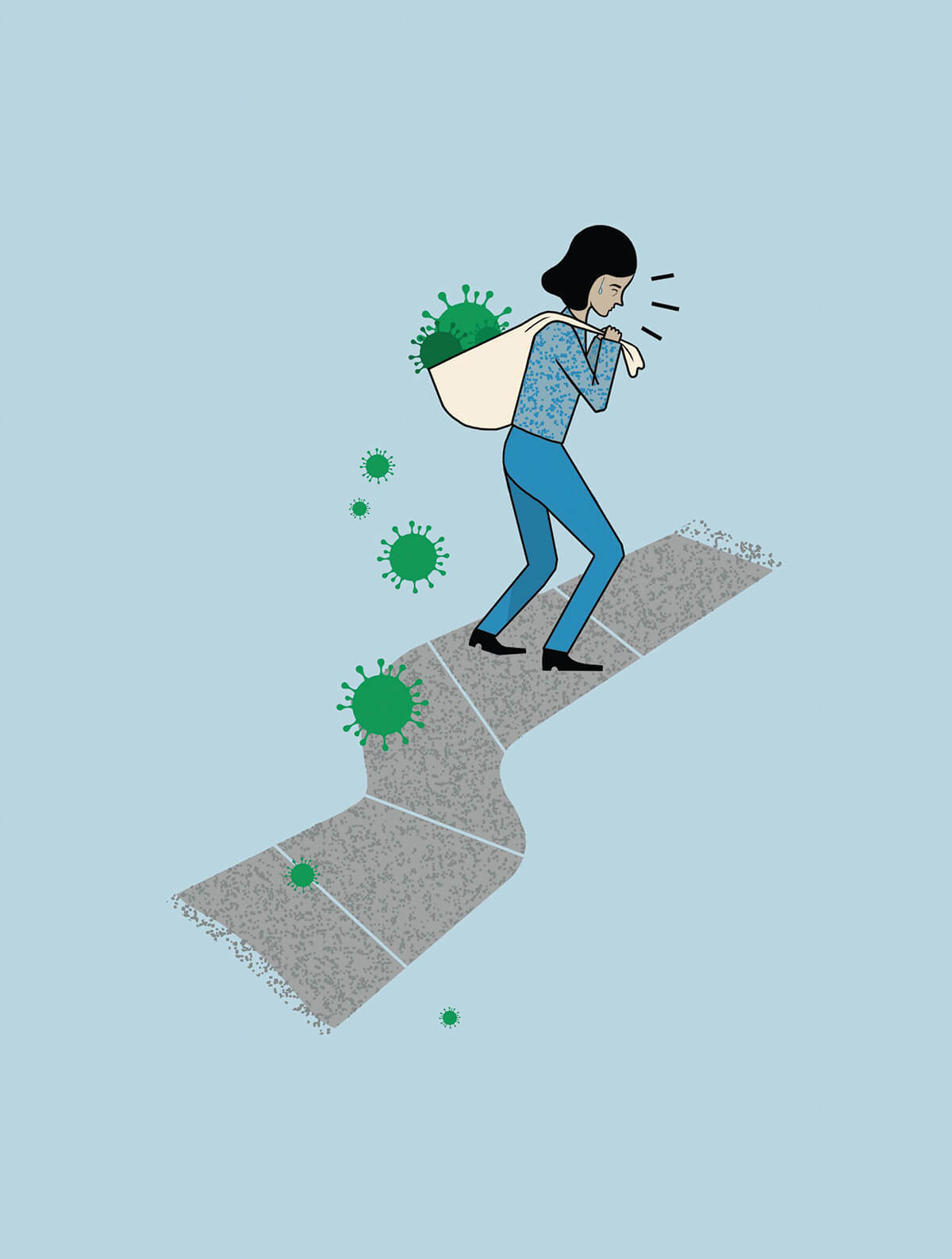COVID-19
In It For The Long Haul
Will long COVID change the way Western medicine treats chronic health conditions?

It started with shortness of breath. While taking a basket of laundry downstairs to the basement, Mallory Stanislawczyk got winded, which had never happened before. Hours later came the low-grade fever, nausea, and the worst body aches she’d ever had. She took five hot showers that first day of COVID-19 in December 2020 and started taking Tylenol and Advil around the clock.
Seventeen days into COVID, Stanislawczyk went to the emergency room because she was worried about her breathing difficulties. They ordered bloodwork and gave her a chest X-ray. Everything came back normal, no signs of pneumonia or clots.
“They gave me an inhaler, started me on oral steroids, and sent me home. And slowly the weeks went by, and I just wasn’t improving.”
By then, Stanislawczyk had lost her sense of smell and began experiencing brain fog and worsening fatigue. Doctors were advising she’d feel better before too long. But a week later, her heart was racing after shoveling snow in the driveway—also unusual. Thinking it would pass, she tried returning to her job as a pediatric nurse practitioner in Frederick, but she couldn’t manage it. She couldn’t breathe. She couldn’t get through a sentence without having to take multiple breaths.
January 7, 2021 was her last day of work. Ten months later, Stanislawczyk is still unable to return to her job and struggles, at times, to care for herself—let alone her 2-year-old daughter, who has also tested positive and exhibited symptoms of long COVID.
Stanislawczyk’s story is just one of millions. While the world watched as the COVID-19 pandemic’s wave of cases, hospitalizations, and deaths rose and fell over the past 18 months, a quieter epidemic was taking shape, and this wave is still rising.
For this subset population, self-dubbed COVID long-haulers, the illness never really goes away. They’re not still critically ill, but they’re not all better, either. Instead, they are beset with a laundry list of ongoing symptoms—shortness of breath, brain fog, fatigue, headaches, dizziness, skin rashes and swelling, tinnitus, night sweats, and sleep disturbances. Modest estimates list about 50 symptoms; more generous lists have up- wards of 200.
“There’s a lot out there regarding treatments and protocols,” says Dr. Alba Azola, co-director of the Johns Hopkins Medicine Post-Acute COVID Team (PACT) in Baltimore. “And there’s desperation from these patients. They want to get better, and everybody’s telling them nothing’s wrong with them. They’re willing to kind of try everything…but at this point, for the long-haulers, there is no magic wand, no magic pill.”

Long COVID can affect nearly every organ system. It affects people of all ages, regardless of how healthy they were prior to getting COVID, and it affects more women than men, and more people in the 25 to 45 age range. While statistics vary wildly, studies estimate that anywhere from 10 to 30 percent of those with a COVID infection experienced ongoing symptoms.
Meanwhile, support groups cropped up in the early months of the pandemic, perhaps most notably Survivor Corps, which has grown to not just provide support and connection for those suffering from the condition, but also to accrue invaluable data, participating in studies, and working with a number of hospitals and universities across America to find answers.
The Centers for Disease Control and Prevention eventually recognized long COVID as a disease, officially calling it Post-Acute Sequelae of SARS-CoV-2 infection (PASC), and acknowledging that it includes both physical and mental symptoms. The CDC website simply directs doctors treating long COVID patients to “approach treatment by focusing on specific symptoms (e.g., headache) or conditions (e.g., nerve disorder dysautonomia)” and notes that most can be treated by their primary-care doctors, while also noting that research is ongoing, and guidance will “likely change over time as the evidence evolves.”
“WE STILL DON’T UNDERSTAND WHY SOME PEOPLE HAVE LINGERING, PERSISTENT ILLNESS, EVEN IF THEY WERE NOT CRITICALLY ILL WITH OBVIOUS ORGAN DAMAGE.”
Perhaps another small “win” for long COVID sufferers, the Biden administration in July announced that those with long COVID now qualify for American disability resources and federal protections, as stated in the Americans With Disabilities Act.
In Baltimore alone, three long COVID clinics have cropped up to help provide what is o en ongoing treatment from various specialists. The Johns Hopkins Medicine Post Acute COVID Team (PACT) and the UM Rehabilitation and Orthopaedic Institute COVID Recovery Rehabilitation Unit provide similar treatment for adults, while the Kennedy Krieger Institute’s Pediatric Post COVID-19 Rehabilitation Clinic focuses its efforts on children. Also promising: the Bethesda-based National Institutes of Health received more than $1 billion to research long COVID.
But this disease is still in its infancy, and even doctors who have been working closely with long-haulers for more than a year don’t have the answers. They’re still putting the pieces together, while patients wait.
One of those trying to solve the puzzle is Dr. Andrea R. Levine, MD, an assistant professor of medicine in Pulmonary and Critical Care Medicine at the University of Maryland School of Medicine. Her long-hauler patients include people who spent time in the ICU, as well as those who never went to the hospital for COVID. She sees these as being two distinct groups of patients.
“I have patients who were critically ill with COVID, they were in the hospital for a couple weeks, and they have symptoms related to having had severe pneumonia,” says Levine. “They have symptoms of fatigue and weakness because they were critically ill. Eventually, they come see me because they’re still having symptoms related to their COVID-19 illness, but, to me, that’s different than a patient who was home with chills and shortness of breath and now is so fatigued and weak that they can’t walk their dog. To me, they’re different disease processes…and we still don’t understand why some people have lingering, persistent illness, even if they were not critically ill with obvious organ damage.”
“I know it seems like a long time, and we’re all exhausted by COVID, but we’re so early in the course of this. Being only 18 months into it, as far as having effective drug therapies, is really early. It’s a little more complicated than the acute, critically ill COVID-19 patients, where we’re seeing these massive international studies being conducted to rapidly try to find therapeutics,” says Levine.
“I want to push for people to get vaccinated, especially if they’re young and think COVID is going to be like the flu,” she says. “Even if they’re not worried about getting critically ill and being put on a ventilator, I would be worried about having these persistent symptoms that keep you permanently out of work. Okay, maybe you’re not scared of being in the ICU because you’re a generally healthy person, and statistically, you probably won’t be in the ICU, but I think people should be respectful and fearful of the fact that you could end up with this low-level illness and still have persistent symptoms.”
It was in February when Stanislawczyk got an appointment with Dr. Azola at Johns Hopkins, who recognized fairly early on that she was suffering from a common long-COVID condition, POTS, although it would be another few months before Stanislawczyk could be seen at the Post-COVID POTS clinic there.
Postural orthostatic tachycardia syndrome, or POTS, affects the autonomic nervous system’s ability to regulate blood ow and therefore causes dizziness, fainting, and a rapid heartbeat while standing, as blood is not circulating throughout the body the way it should.
Stanislawczyk started medication for POTS, wears compression socks, and began physical therapy and IV hydration infusions three times a week via a midline, which stays inserted continually to supply fluids.
Long COVID often affects the autonomic nervous system, which regulates things you don’t think about—breathing, heart rate, digestion, blood pressure, temperature control, among other things.
Darleen, 38, who asked that we use an alias, is another nurse practitioner who has been out of work at Johns Hopkins Pediatric Allergy since April. When she, her husband, and children contracted COVID in December 2020, the kids recovered in about a week, though one son had lingering fatigue and headaches for several months.
“I continued to push through my symptoms, preparing gifts and finishing up my work commitments before the holiday break,” she says.
She spent Christmas Day severely fatigued and throwing up. “It was a wakeup call that I needed to slow down,” she says.
But she started to struggle with basic functioning, even without pushing herself. She’d stopped exercising and tried to rest as much as she could, but she was exhausted by the simplest things: preparing a meal, attending a virtual work meeting from home. She could barely read to her daughter at bedtime because her headaches were so bad, and she’d sometimes spend entire weekends in bed, holding an ice pack to her head. Her brain fog got so thick, she started to forget whole conversations. She got vaccinated in March, having heard some long-haulers see a remission of symptoms. It didn’t help.
“On April 9, my last day of work, I pushed through the headache and fatigue all day. I was running on adrenaline,” she says. “On the drive home, I developed blurred vision and severe head pain. When I got home, I collapsed into my bed and thought I could sleep it off. The next morning, I couldn’t lift my head off the pillow without my heart racing and pounding, severe head pain, and nausea. I blacked out several times and felt like the bed was spinning. I had symptoms in almost every body system and felt like my body was shutting down. That was the last day I was able to work.”
After seeing a cardiologist—who dismissed the symptoms as anxiety and said, “Everyone wants to blame everything on COVID”—Darleen found the clinic at Hopkins and began physical therapy, as well as meeting with a neuropsychologist who helped her recognize patterns of activity that cause are symptoms. She also attended a research study at NIH, where she learned she had some markers of heart inflamation. Most recently, she was officially diagnosed with POTS.
“In May, I had a brief period of relief when I attended my son’s baseball game and watched the kids swim in the pool,” she says. “I felt like a mom again and saw glimmers of hope for a normal life.”
Now nine months into the illness, Darleen can move around the house better but still spends 18 to 20 hours a day in bed and needs a wheelchair to leave the house. The research can’t move fast enough,” she says. “I want to go back to Hopkins as a nurse practitioner,
not a patient.”
No one knows for sure whether long COVID is caused by lingering virus remaining in the body or because the infection triggered an autoimmune response that continues. Another hypothesis is that COVID triggers the once-dormant Epstein-Barr virus to reactivate, because of overlapping symptoms (severe fatigue, night sweats, etc.). Some researchers believe that it could be something else entirely or some combination of all three.
Some patients are slowly getting better with lifestyle and dietary changes, alongside medication—and, perhaps, time. Others experience symptoms that are cyclical in nature. And still other patients experience are-ups a er feeling better, often following a period of intensified physical, emotional, or mental exertion—a trait similar to Chronic Fatigue Syndrome sufferers.
The effect of vaccines on long-haulers is just as puzzling. Dr. Azola estimates that about a third of long-haulers being treated at Johns Hopkins feel better a er receiving a vaccine, a third remain the same, and a third relapse.
In the meantime, doctors not just in Baltimore but across the globe are working to give long-haulers a better quality of life, at least until the science catches up.
“A lot of times, we have to test for what we know, to make sure the most dangerous things aren’t happening,” Dr. Azola says. “For example, some patients with sensations of heart pressure and pain and palpitations could have ischemia or myocarditis, so we do tests, such as an echocardiogram and Holter monitoring.”
Similarly, doctors first try to rule out treatable causes of fatigue, arguably the most common symptom of long COVID, by testing for thyroid disorders and deficiencies in vitamins D and B12 and iron.
“I HAD SYMPTOMS IN ALMOST EVERY BODY SYSTEM AND FELT LIKE MY BODY WAS SHUTTING DOWN. THAT WAS THE LAST DAY I WAS ABLE
TO WORK.”
At Johns Hopkins, patients (about 750 total) are referred to specialists—cardiovascular, pulmonary, endocrine, auto-immune, etc.—depending on their needs. Social workers are also part of the team.
“A multidisciplinary approach really makes a difference with patients. Collaboration within the different specialties is super important,” Dr. Azola says. “We work pretty holistically when looking at the patient, giving them lifestyle modifications to improve their quality of life, and we understand the importance of not only the medical side but treating the whole patient, their family, accommodations, work….We want patients to be living their best lives, but their lives are not going to look the same as before they got COVID.”
Another approach is taken by Baltimore acupuncturist and traditional Chinese medicine herbalist Nicholas Tomaskovic-Devey, who says Chinese medicine sees illness in a macrocosmic way.
COVID, as seen through the lens of TCM, is a virus that affects the places in our bodies where we have blood stagnation. Blood stagnation on an advanced level, Tomaskovic-Devey explains, is a tumor. Earlier blood stagnation is a random, shooting pain in your shoulder or blood clots, places where the blood doesn’t flow so well. For some people, that’s their lungs. For some people, that’s their intestines.

“COVID goes to those places and puts its spikes into where the blood doesn’t move,” Tomaskovic-Devey says. “Whatever your chronic issues are, they’re going to be exacerbated when you get COVID, and everybody’s got chronic illnesses. COVID is a lot of things, and one of them may be a way to make sure people own their lives, just like Lyme disease does. You pretty much have to be enlightened, if you have Lyme disease. You have to be healthy. If you’re not spiritually healthy, mentally healthy, physically healthy, then Lyme starts to increase its numbers in your body and takes over. COVID is similar. It demands that your consciousness, your awareness, your memories don’t stagnate.”
But while the debate goes on over treatments, masks, mutations, mandates, and the efficacy of the shots, Stanislawczyk and others like her feel pretty much on their own.
“I tell people who don’t want to get the vaccine that death is not the worst thing that can happen,” Stanislawczyk says. “I mean, I’m glad I’m alive, but I’m so beyond frustrated.”